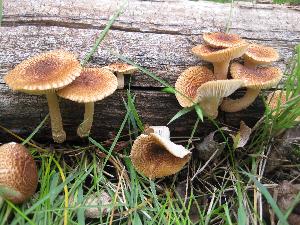
Heliocybe sulcata
The genome of Heliocybe sulcata has been sequenced under the auspices of the 1000 Fungal Genomes Project. It represents the second sequenced species in the Gloeophyllales, a relatively small order containing saprotrophic mushroom-forming fungi that produce brown rot mostly on conifers, more rarely on broadleaved tree species. Species of the Gloeophyllales display a high diversity of fruiting body morphologies, with crust- or shelf-shaped and agaricoid types being most common. The Gloeophyllales represents an independent origin of agaricoid mushrooms, i.e. morphologies with with distinct cap and stipe in the Agaricomycetes. Heliocybe sulcata, the only species in its genus, produces centrally stipitate fruiting bodies with flexible, rubber-like distantly spaced gills and a deer-brown squamose, cracked cap surface. The edge of the cap often appears strongly and deeply sulcate, hence its species name.
Heliocybe grows on unusual substrates and places, including sun-dried wood in exposed sunny places, fence posts, railroad ties, etc. Heliocybe shares the adaptation to low-humidity, exposed places with its close relative, Neolentinus lepideus, however, that species forms larger fruiting bodies with crowded, decurrent gills. Curiously, fruiting bodies of Heliocybe can revive after desiccation, which is another way for this species to combat desiccation and extremely dry habitats. By comparing the genome of Heliocybe to that of Neolentinus as well as other brown-rot Agaricomycetes, we expect to gain an insight into the evolution of their adaptation to extreme environments and the genetic bases of agaricoid mushroom production within the Gloeophyllales.
Genome Reference(s)
Varga T, Krizsán K, Földi C, Dima B, Sánchez-García M, Sánchez-Ramírez S, Szöllősi GJ, Szarkándi JG, Papp V, Albert L, Andreopoulos W, Angelini C, Antonín V, Barry KW, Bougher NL, Buchanan P, Buyck B, Bense V, Catcheside P, Chovatia M, Cooper J, Dämon W, Desjardin D, Finy P, Geml J, Haridas S, Hughes K, Justo A, Karasiński D, Kautmanova I, Kiss B, Kocsubé S, Kotiranta H, LaButti KM, Lechner BE, Liimatainen K, Lipzen A, Lukács Z, Mihaltcheva S, Morgado LN, Niskanen T, Noordeloos ME, Ohm RA, Ortiz-Santana B, Ovrebo C, Rácz N, Riley R, Savchenko A, Shiryaev A, Soop K, Spirin V, Szebenyi C, Tomšovský M, Tulloss RE, Uehling J, Grigoriev IV, Vágvölgyi C, Papp T, Martin FM, Miettinen O, Hibbett DS, Nagy LG
Megaphylogeny resolves global patterns of mushroom evolution.
Nat Ecol Evol. 2019 Apr;3(4):668-678. doi: 10.1038/s41559-019-0834-1
